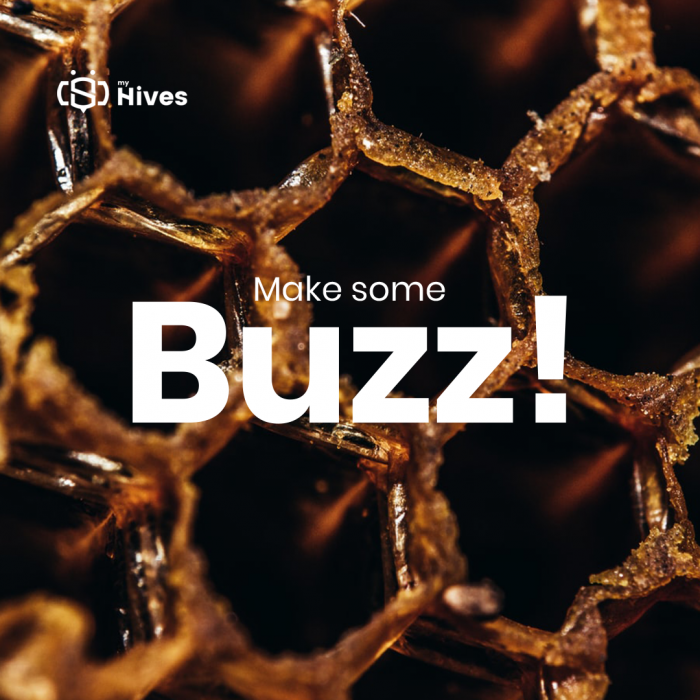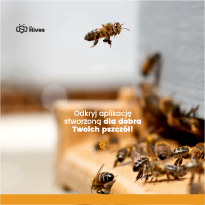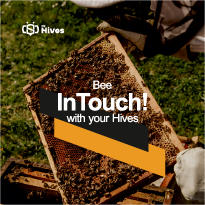I. SUMMARY INFORMATION
Project
268022
Status
Submitted
Award category
Products and life style
You want to submit
NEW EUROPEAN BAUHAUS RISING STARS : concepts or ideas submitted by young talents (aged 30 or less)
Project title
My Hives
Full concept/idea title
App for data analysis with the use of Computer Learning mechanisms for the beekeeping industry
Description
It's all about th bees.
The more we know about their lives, the better and more effectively we can help them. The loss of one of the most important pollinators is threatening the environment. Each beekeeper who digitally monitors his or her hives has a valuable tool for managing and better taking care of honeybees. Such efforts directly help local bees. Get closer to nature. Become a part of nature’s reproductive mechanisms by learning how to keep bees the smart way.
Bee-well!
Where is your concept/idea being developed or intended to be implemented in the EU?
Poland
Lubuskie
Al. Konstytucji 3-go Maja 8, 8
51.9356779
15.507151
Zielona Góra
65-803
II. DESCRIPTION OF THE PROJECT
Please provide a summary of your concept/ idea
OUR MISSION
It’s all about the bees.
The more we know about their lives, the better and more effectively we can help them. The loss of one of the most important pollinators is threatening the environment. IoT can address these challenges by granting us deep insight into hives before and as problems arise. That is why we decided to create 24-hour hive monitoring that visualizes hive parameters, such as temperature, humidity, weight, sound frequency, location, and much more. Each beekeeper who digitally monitors his or her hives has a valuable tool for managing and better taking care of honeybees. Such efforts directly help local bees. Get closer to nature. Become a part of nature’s reproductive mechanisms by learning how to keep bees the smart way. Contribute to science. Through My Hives, you will be sharing valuable information with scientists working on saving the bees. Bee-well!
How does it work?
1.Monitoring system.
Weight, temperature, and humidity data are gathered at regular intervals by a monitoring system installed in the hive.
2.Data transfer.
Gathered data is sent to the server.
3.Data analysis.
Gathered data is continuously analyzed using algorithms (created using beekeepers knowledge)
4.Your mobile device.
Alerts are sent to the beekeeper's mobile device.
- Production start - Production End - Swarming alert - Swarming - Queen status
Our target in My Hives to make the application customized for all beekeepers in the world and accomplish all beekeepers' dreams using our IoT technologies we made. These goals are based on our dream which is a better life for the bees because they are one of the main pillars in our ecosystem, so better life for bees means a better life for humanity.
Please give information about the key objectives of your concept/idea in terms of sustainability and how these would be met
We want to infect others with ecology, proving that sustainable development is possible even by introducing urban beekeeping. Apart from its ecological value, urban beekeeping can protect bees from the dangers they face in modern apiaries. Urban areas are an ideal place for bees. Let us remember that in fact only 30 per cent of a city's area is built up or concreted over. The remaining 70 per cent are parks, gardens and squares, which are ideal places for bees to forage. Bees, thanks to their pollination function, can help many plants from dying out and becoming extinct. Keeping bees in cities encourages the development of parks, gardens and other green recreational areas. By inviting bees into city gardens or allotments, we can be sure that they will return the favour with lush vegetation and better crops.
Please give information about the key objectives of your concept/idea in terms of aesthetics and quality of experience beyond functionality and how these would be met
Bees, the first word normally in this paragraph is the name of our brand but here we are starting with the name of the creature that responsible for our ecosystem balance, and as a part of this favor which bees gave us, we invented “My Hive” to help beekeepers understanding their bees in apiaries. My Hives is a web application that runs on any device that has a web browser. My Hives designed to satisfy most requirements of beekeepers asked for like showing some statistical graphs collected from hives to understand the state of bees in each hive. It can follow up the states of bees’ queens and follow up each hive in each apiary with easy steps, also beekeepers will not forget any task they want because there a task manager for them in the application directed for their types of tasks only. All of this not be completed without notifications to remind the beekeeper of a task or alert him for something wrong in any hive. To understand how the application works we will start from the hive till the beekeeper and how data flows from one component to other, and it supposed to be mentioned the hardware part in this project follows the IoT architecture to achieve scalability, reliability, and the target of power management. The first component is the “node” which is a device designed specifically for this project, it has some sensors to collect from the hives data like temperature, humidity, pressure, weight, gyroscope, bees’ vibration frequency, and vibration amplitude. Nodes are powered by batteries and they can be charged using a USB charger or a solar panel, and our initial tests achieved our target in power management which is one charge for the whole spring season.
Please give information about the key objectives of your concept/idea in terms of inclusion and how these would be been met
To send data from nodes to the second main component in the project which is “Gateway”, we are using LoRa 433 for this part to give us a range from 500m to 750m radius between nodes and a single gateway which is beyond our competitors. Also, the compression algorithm in the nodes makes the gateway handles 900 nodes at the same time with the default configuration that grantee one readings for each node every 30 minutes. It should be mentioned that we choose this frequency 433MHz of LoRa to make absolutely sure it cannot harm bees and based on [1] and [2], the frequencies that may harm with low impact on bees starting from 600MHz and we are using technology below this. Many applications using 2G/3G/4G to send data directly to the cloud but works from 800MHz to 1200MHz and consume more power, and other applications using Wi-Fi which has more impact on bees because it’s using 2.4GHz.
Gateways are used to bridge between non-TCP/IP networks like LoRa and TCP/IP networks Like Ethernet, Wi-Fi, and 2G/3G/4G. The gateway is managed by another android application called “GaMP Gateway”, the separation between two applications because the gateway architecture is modular and may supports future IoT applications using LoRa or adding other protocols like SigFox or Z-wave. Like nodes, gateways power by batteries and can be charged with USB or solar panel and it’s recommended to make the batteries is the backup power source, not the main one to guarantee not losing any data from the nodes. In addition, if all connections between the gateway and cloud are down, all data collected are buffed in the gateway till the connection is returned.
We have a goal in the hardware part which is the cheapest node in the market with the cheapest operating expenses also because if there is a SIM card in each node means more operating expenses which makes the beekeeper throw the idea of the whole project. With the LoRa there are no operating expenses for the communication on each node.
Please explain the innovative character of your concept/ idea
The first back-end is responsible to collect data from gateways and store it in a Time-series database called InfluxDB which is the best suitable for our storage because fast reading data using time indexes compared to normal SQL databases. Grafana is a service used to read the data from InfluxDB and represent the data in some managed and good-looking graphs to give meaning to the collected data. This backend has a machine learning model used to analyze the data collected from gateways and extract some knowledge that can help beekeepers to understand the environment around their bees like Queen-loss situation, pre-swarming event, swarming event,… etc. Our model will use Reinforcement Fuzzy Trees (RFT) making the new experience collected from beekeepers feedback will be added automatically in the model and getting stronger and more accurate over time, also this model will filtering the bad reading data from nodes and detect abnormally spikes if it’s some noise in the reading or it’s an event happing. The second backend is normally for Create, Read, Update, and Delete (CRUD) of the database in the application which uses a Microsoft SQL server and encapsulated in Restful API to satisfy all the needs of our front-end. This back-end uses C# as a programming language and ASP.Net Core 5 as a web framework which is the latest stable release of this framework and we are waiting for version 6 because it’s more performant, secure, and has long-term support (LTS). Of course, we are using an Object-relational mapping (ORM) with this application using Entity Framework Core 5 (EFCore). On the other hand, the other backend using Python 3.8 as a programming language and Flask as a web framework, we choose python for the ease of the implementation of the ML model in this language using TensorFlow which giving GPU processing if we will need it in the future.
Please detail the plans you have for the further development, promotion and/or implementation of your concept/idea, with a particular attention to the initiatives to be taken before May 2022
Currently, the product is being prepared for environmental testing. In the meantime, we are building a community of beekeepers, to whom we want to make our solution available. At the same time, we want to build a conscious group, which through the exchange of mutual information will allow us to create better-living conditions for bees. We want to appear at international events, create an online guide and, above all, educate the public and motivate them to further action. The front-end designed to satisfy most required features by beekeepers, and our goal to satisfy all they required by customizing the web application with settings that suitable for every beekeeper in the world. And on the mentioned level the application supports now three languages: English, Polish, and German, also the design follows Web Content Accessibility Guidelines 2.1 (WCAG) and the dark theme is supporting AA and AAA color-blind standards. DevOps tools are used to make the development team work smoothly on all the components of the project because it has variant services, so we containerized our services and using Docker and Docker-Compose to manage the images of our services in our private repository, and all our code managed in our Git repository. Also, we are logging all the events that happened in the back-ends and saving them to trace any misbehavior or errors in the application and still working for a better representation for these logs. Any new requirements in the application take an agile sprint, analyzing the requirement and its goals and its output on the beekeeper. The second step is the designing phase which makes us revise all project diagrams and edit them, also edit the UI/UX design using Adobe XD. The Third step is implementing these changes based on the diagrams we designed. The Fourth step is testing all the project components and fixing any component level errors or integration level errors.
III. UPLOAD PICTURES
IV. VALIDATION
By ticking this box, you declare that all the information provided in this form is factually correct, that the proposed concept/idea has not been proposed for the New European Bauhaus Rising Stars Awards more than once in the same category.
Yes


